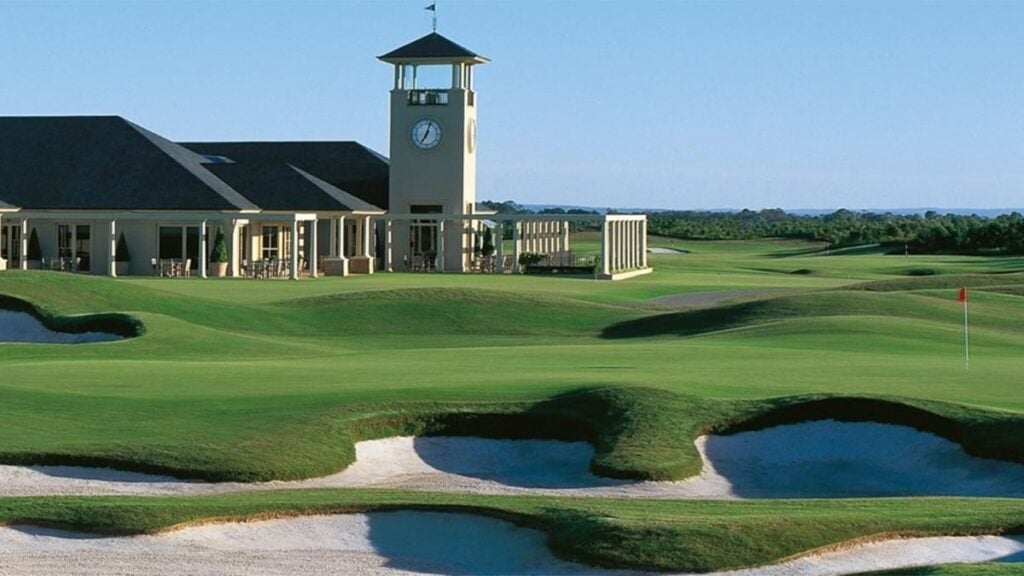Measuring caddie credit in pro golf is a subjective exercise. Few moments are as clearcut as Steve Williams calling Tiger Woods off a bounced-in sand wedge from deep rough in favour of a risky, nuked and spinning lob wedge on the 72nd hole of the 2008 US Open, setting up the most momentous 12-footer ever. Usually, only the two people involved really know what the caddie provided, and even for them, there’s an element of mystery.
However, no ambiguity exists about what transpired between Ernie Els and Cayce Kerr after the first hole of the 2016 Masters. While calling Els’ six-putt from three feet an unforgettable moment in golf history might be a stretch, labelling it the hardest to erase from memory wouldn’t be.
Whether on the original CBS TV telecast or on replay, the 40 seconds of horror can’t be unseen. A ground-level close-up of the first putt captured the toe of Els’ putter seized by an evil twitch that produced glancing contact and a slapstick pull. His next three attempts, all from closer range, never touched the cup. The fifth putt, a one-footer hit one-handed, grazed the lip, while the sixth was raked in for a quintuple-bogey 9.
With each miss, Els reacted with the same sad, palms-up, “I-told-you-so” half-gesture directed at his caddie. Before the trainwreck commenced, Els had softly but shockingly confided in Kerr that the initial par putt seemed impossible.
“Ernie told me the putter felt like a snake,” says Kerr, reminiscing at a breakfast nook in Augusta during the 2025 Masters. Caught off guard, Kerr could only think of suggesting the same improvised, on-the-spot-instructions he had once given to David Frost in a similar crisis: close your eyes and while swinging the putter, do 10 toe raises and take 10 deep breaths. Frost holed the ensuing putt, but after Els performed the ritual, all he could report was feeling worse.
In the excruciating sequence that followed, Kerr had the same chilling thought that those who watched in person and on television doubtless shared. “It seemed like Ernie’s career was ending right before my eyes,” Kerr says. Catching himself, he then felt a strong call to action. “I knew he needed all the help I could give him, and that I had a lot to give. That round turned out to be the best I ever caddied in my life.”
Both men sensed that this was an emergency. “You know what makes a great caddie?” says Kerr. “A great player. When they are playing well, it’s fun and exciting and they don’t need a lot of assistance. But when everything is awful and he’s lost and desperate and you dig deep to help minimise the psychological damage, that’s when you really earn your money.”
Kerr, now 64, whose given first name is David, came to golf late. In the 1970s he was a formidable amateur boxer in the same Washington DC system that produced Sugar Ray Leonard but decided not to turn pro and left the sport at 18. After several years of gritty jobs that included chimney sweeping, concrete construction and managing a liquor store, he learned that he could make $1,000 a week caddieing at Congressional Country Club. His work ethic and thoroughness led to him being called “Pro”, which in the caddie tradition of oblique nicknames morphed into “Cayce”, after the club’s actual head pro at the time Kent Cayce.
Kerr ventured out on the PGA Tour in 1987, and in his fourth event talked his way into a job with Hall of Famer Hubert Green, with whom he stayed four years. Extended stints with Fuzzy Zoeller, Fred Couples and Vijay Singh followed, but it was the several dozens of other players he picked up, either on off weeks or between regular bags, in years when he might work more than 40 tournaments worldwide, that earned his reputation as an ironman among his peers. All told, Kerr has looped in 1,000 tournaments including more than 100 majors. The 2016 Masters marked his 30th consecutive trip to Augusta National as a caddie.
While he prides himself on a solid and emotionally level style on the course, Kerr is known as a colourful and loquacious raconteur off it – the caddie entrepreneur extraordinaire. When golf rangefinders first came out, Kerr bought 350 of them for $1,000 apiece in a deal with the manufacturer and within a year sold all of them at $3,300 each throughout the pro golf world. Other profitable ventures have been flavoured ice coffee, memorabilia sales and a side hustle transporting players’ clubs to the next tour stop in his eponymous 2005 Chevy van, which logged 727,000 miles before being retired to his driveway in San Antonio.
“I always wanted to be a millionaire, and I made it,” Kerr says. “In my opinion, no one can outwork me.”
Kerr has had to slow down. In 2022 he was diagnosed with stage-four rectal cancer, requiring surgery to remove a tumour and extensive chemotherapy. He’s currently in remission, with the hope of caddieing again, but has stayed busy as a businessman and writing a memoir entitled Walking With Greatness with US-based Australian golf writer Andrew Both. Even in convalescence, the man has a huge motor.
Els was Kerr’s last regular bag. When the two got together in early 2016, the South African was a four-time major winner and a Hall of Famer, but at 46, hadn’t won anywhere since 2013. He and long-time caddie Ricci Roberts had taken one of their periodic breaks from each other, and the fill-in, Colin Byrne, had dropped Els’ bag mid-round at Bay Hill, tired of verbal abuse.
“I would find out later that Ernie could be a teddy or a grizzly, but you never knew which bear would come out,” Kerr says. “If it was the grizzly, you needed a double Kevlar jacket of thick skin. To the fans he was always the Big Easy but not to the caddies.” Kerr says he was also unaware that Els had developed an intermittent case of the yips.
After Kerr separated from Mark O’Meara, he and Els had a decent T-38 start at Houston as a warm-up to the Masters, where practice rounds went well. However, everything changed after Thursday’s first hole.
After Els putted out, he told Kerr, “I just feel like walking in.” For a long moment he stood still, fixed on the not-so-distant clubhouse, literally at a crossroads. “He looked like the Washington Monument,” Kerr says. “Fortunately, he didn’t move. I knew that his first step had to be in the right direction.
“My thought was to get him going to the second tee. I came up with a complete bulls–t lie, but I delivered it gently. ‘Look,’ I said, ‘there’s an official down on the second green. He’ll have a cart. Let’s play that hole, and if you want to go in, you can get a ride.’” Then I kind of herded him that way, and he came along.”
With his second shot to the par 5, Els hit a majestic 3-wood to 10 feet behind the hole, but even with Kerr urging a lag, Els left himself a four-footer that did not touch the cup. “Even the last one-footer for par did a 360 before barely dropping in,” Kerr says.
But at least Els didn’t look for the fictitious official in a cart. Instead, he began to settle in and even birdied the fifth with an accidental 20-footer, although he soon resumed his abysmal results from short range.
As the round progressed, Kerr’s mind went back to his amateur boxing days, when his coaches would buck him up during tough moments. Now he was the cornerman.
“Ernie didn’t say anything, but he got into grind mode, his champion’s pride at stake,” Kerr says. “I just walked with energy and stayed in his ear, speaking with compassion but not overdoing it because anything phony would have set him off, just pumping him up, reinforcing that he was Ernie Els and to show these people who he was. I dug deep, and he dug deep. It was hard because he was putting so poorly, but because of how he had come back from that first hole, it was exhilarating.”

Els shot 80 with 39 putts. “I’m a little dead inside,” he confessed to the media. “I don’t know how I stayed out there.”
“I had ridden to the course with Ernie and his wife Liezl,” Kerr says, “and during the round I was kind of dreading the return ride. I wanted it to be free of any suspicions that I had quit on him, and there wasn’t. In fact, he thanked me, saying, ‘Caseman, you gave me 100 percent today.’ I answered, ‘And tomorrow, I’m going to give you 110 percent.’ But I’ll tell you, I’ve never been more exhausted after a round.”
The next day, Els shot an admirable 73, fittingly finishing it off with two missed four-footers. The next week at Hilton Head, Els recovered with a T-14, and, remarkably, led the statistical category of total feet of putts made. It was the second-best finish Els and Kerr had together in their three years on the PGA Tour, which ended when Els turned 50. Anyone who follows the PGA Tour Champions knows that Els is a dominant presence, with seven wins as of this writing. Els remains a friend, lending
his name to one of Kerr’s beverages, Els Iced Coffee.
“You know, I was made to be a tour caddie,” Kerr says wistfully. “How can I say it? It’s a sexy job, you know, being inside those ropes with the best in the world, feeling the heat. My own mix of talents matches the job well, especially the big one, coming up with right thing to do and say at the right moments, usually with no time to think about it. After that first hole, I did that all day with Ernie.”
The tough campaigner falls quiet for a moment, his eyes welling until two damp streaks roll down his cheeks.
“Who knows how much time I have left, but I’m just going to fill it with good stuff,” Kerr says, with extra ebullience.
He wants to caddie again. “I’ve got my goal of getting out there again, and I’m good at reaching goals. Like the movie says, ‘Get busy living, or get busy dying.’ For a guy like me, that’s not a hard choice.”
Main photograph by sam greenwood/getty images



